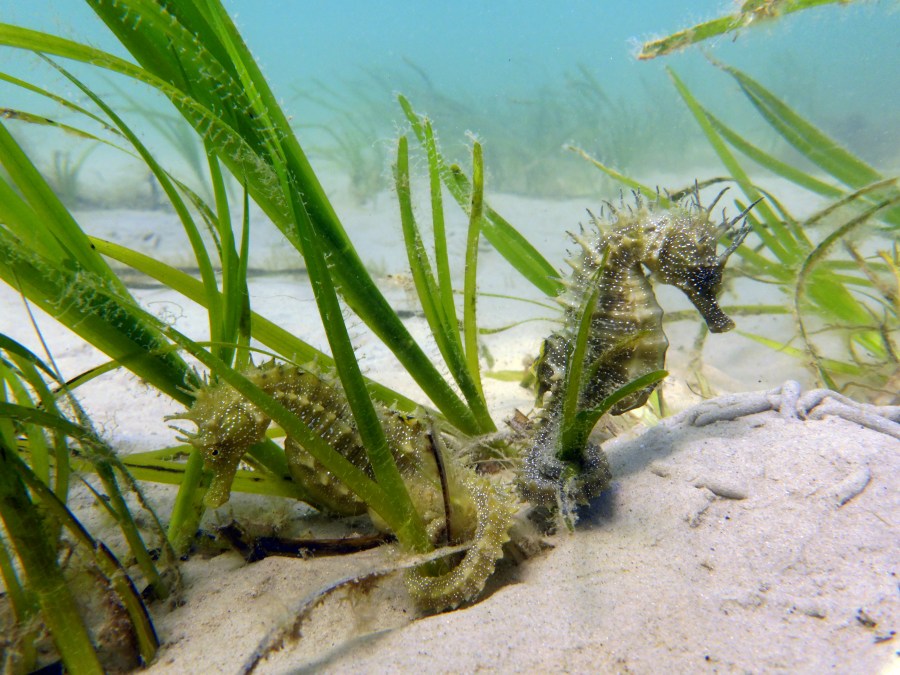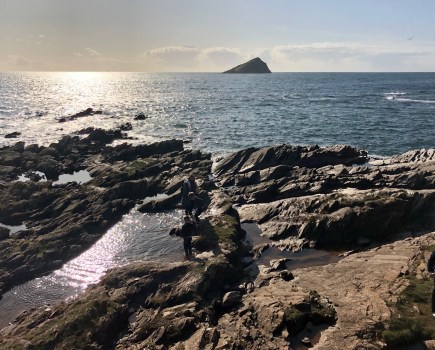There’s something mysterious and beautiful around our shores. SIMONE STANBROOK-BYRNE learns more about the enigmatic coastal creatures of seahorses and how to look out for them.
Wouldn’t it be handy to be able to look backwards and forwards at the same time? Even handier, some women may say, if the male of the species endured pregnancy. Impossible? No. For these feats of extraordinary evolutionary engineering are perfectly normal if you’re a seahorse.
I well remember the moment I first became aware that these seemingly exotic and exquisite creatures inhabit British waters. I was at Studland Bay, in Dorset, a location extremely important for its population of wonderful spiny seahorses, one of only two species indigenous to the UK, with around 54 worldwide. Our other one is the delightfully alliterative short-snouted seahorse.
It was a bit of an epiphany for me and one that needed further exploration. This led me to Neil Garrick-Maidment, a fellow of the British Naturalist Association. He also has the accolade of winning the 2023 David Bellamy Award for distinction as a field naturalist. He’s been interested in seahorses since his teens, when his family was involved with the Paignton Harbour Aquarium which was once located in Torbay.
Neil recalls: “The aquarium was run by a lovely man called Les Jackman who became my mentor as a naturalist. He had seahorses in the aquarium and asked me to raise some of the babies, known as ‘fry’. That was 50 years ago and I’m still at it.”
Fast forward to the year 2000. Recognising that these exquisite and very specialist beings needed their own conservation organisation, Neil founded the Seahorse Trust of which he is still director, working with a team of patrons, trustees and volunteers, to further the work and conservation, both terrestrial and aquatic, that he started many years ago.
Since then, the trust has undertaken numerous projects, including the British Seahorse Survey, the World Seahorse Survey and the setting up of the Studland Bay Marine Partnership. Their remit has involved negotiating and working with bodies such as Natural England in the UK, as well as seven different governments around the world and numerous charitable trusts, all with the aim of conserving a marine environment fit for seahorses.
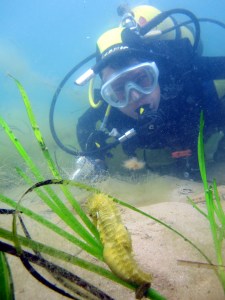
The trust’s work is vital. Seahorses are regarded as an indicator species for the environmental health of the oceans; their presence indicates a good environment for biodiversity in general, and hence for us and the planet.
Descended from pipefish, seahorse physiology has evolved over millennia and they are one of nature’s most highly adapted species. Although they generally shelter in deeper water in winter, in summer seahorses can be found swimming in shallow water – they like the lush areas of seagrass, a marine plant that also plays a vital role in the fight against climate change. Seagrass beds are where we might encounter them, as Neil explains.
“We get lots of reports from swimmers who have come across seahorses either in the shallows as they are snorkelling, or ones that are free-swimming near the surface. We ask that if anyone sees one please report it to us, so that we can add it to the World Seahorse Database. I set this up in 1994 and it’s the longest running continuous database of its kind.”
Neil adds the important point that if anyone actually goes to seek out seahorses, rather than having a chance encounter, they require a licence to do so as, since 2008, seahorses have been a listed protected species under the Wildlife and Countryside Act.
Divers, Neil explains, can provide invaluable information for the trust’s research, but strict measures need to be observed when photographing: don’t touch the seahorse and avoid flash photography as the flashes can kill them through stress. A distressed seahorse will move away from us – and we must let them go, without any sudden movements on our part. Other signs of stress include swimming with a curled tail, holding their head downwards in a chest-hugging posture, lying flat or darkening in colour.
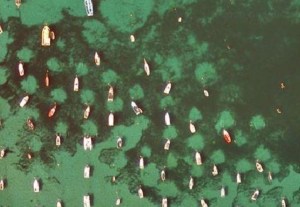
The habitat of the seahorse is a fragile one, and numerous risks on a worldwide scale, besides pollution, beset these enchanting little creatures.
Traditional Chinese medicine takes more than 150 million wild seahorses a year, and more than a million go to supply the curio trade, where seahorses, along with starfish and shells, are left to die miserably in the sun. Another million are taken for the pet trade, few of which survive more than six weeks.
They deserve so much better.
To have seahorses around our coast is a privilege; an encounter is one of life’s magical moments. It’s up to everyone to ensure the magic doesn’t disappear.
Protective partners
The Studland Bay Marine Partnership was created to develop solutions that support sustainable coastal recreation in this Marine Conservation Zone – so-designated in 2019.
Studland Bay is a site with abundant seagrass, beloved by seahorses and environmentally crucial, but it has been impacted by many visiting boats. The trust, with its partners at Boatfolk, have installed 30 eco-moorings, which avoid contact with fragile habitats. Up to 100 are planned, taking pressure off this highly sensitive region.
It’s a commendable collaboration between the boating fraternity, conservation charities, researchers and statutory bodies. Neil says: “The partnership is also looking at seagrass restoration, and the study and management of the site for all. The work will improve habitats for species like Spiny Seahorses into the future.”
Seahorse snippets
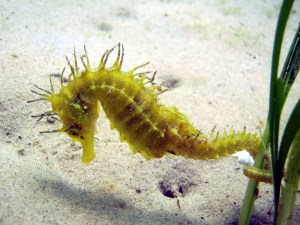
Seahorses are fish, breath through gills and are poor swimmers. Their eyes move independently of one another and they have excellent eyesight. They eat small crustaceans: an adult eats 30-50 times a day, whereas babies eat 3000 morsels of food daily. Their snouts probe for food which is then sucked up through the snout – which can expand if their prey is large.
Pairs meet in the morning in the male’s territory. As they approach each other they change colour then reinforce their bonding with an elaborate display. The female returns to her own, much larger territory and the male gives birth to live young from his pouch after a few weeks; contractions can last for up to 12 hours.
How can we help?
“We encourage everyone to love the coast and sea but to respect it,” says Neil. “It’s a highly fragile, vulnerable habitat, so easily damaged. It’s also the engine that drives our planet, so we humans need it for our future.
“Take your rubbish home, don’t drop pollution into the sea, be careful where you tread – it’s home to other creatures. Those shells you collect might house hermit crabs, leave them for other creatures to live in.”
It goes without saying that we should shun any kind of trade in seahorses, starfishes etc. If you meet a seahorse tell the trust. They need details such as size, distinguishing marks, location, weather and depth. Consider joining the trust – or ‘adopt’ a seahorse as a delightful and unusual gift.

